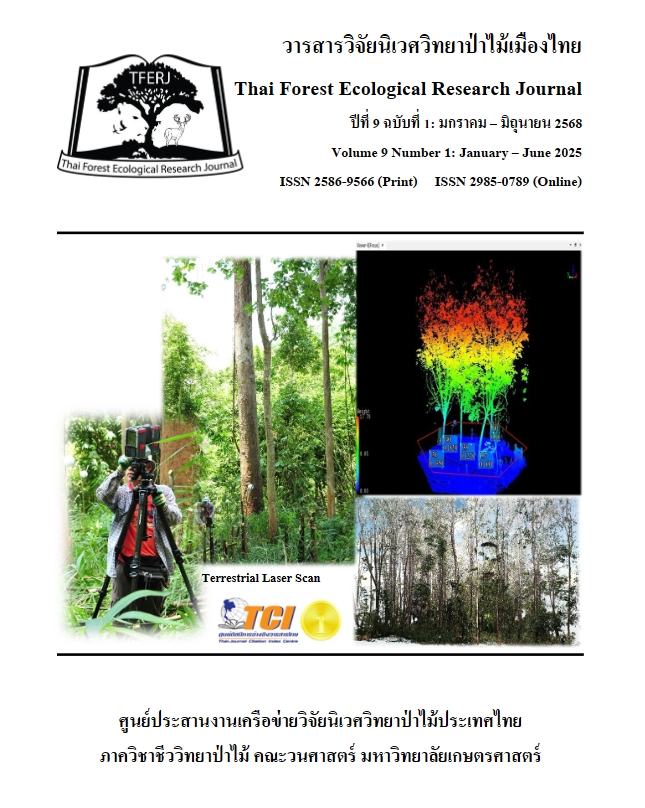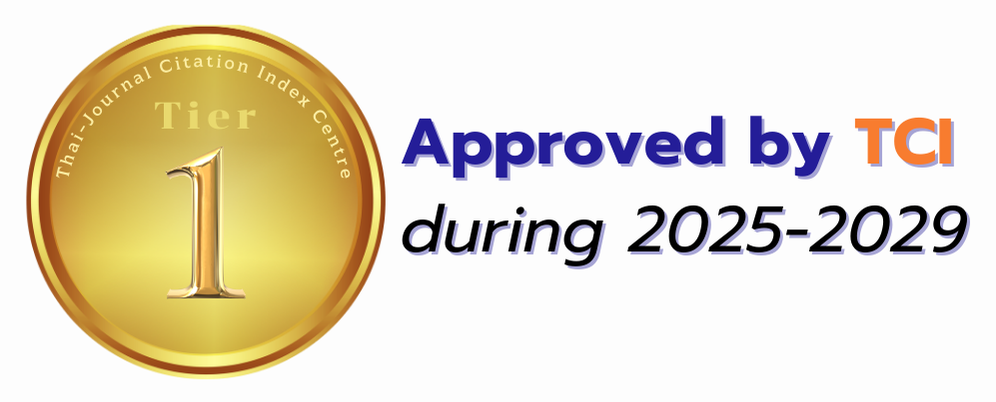Factors influencing and patterns of forest utilization in communities around the Huay Tak Teak Biosphere Reserve, Lampang Province
DOI:
https://doi.org/10.34044/tferj.2025.9.1.6129Keywords:
Forest utilization, non-timber forest products, forest management, National Reserved Forest Act B.E. 2507 (1964)Abstract
Background and Objectives: To establish the land regulation, it is necessary to know basic information of the surrounding community’s land use and to be aware of basic forest laws. Therefore, it is possible to create regulations that are consistent and make the most of the policy. This study aimed to investigate the community’s context, the awareness and understanding of forest law (National Reserved Forest Act B.E. 2507 (1964)), and factors affecting forest utilization in the Huay-Tak Teak Biosphere Reserve, Lampang Province, in order to obtain guidelines for the conservation of the area based on sustainable use of forests.
Methodology: A structured interview schedule was designed to conduct with a sample group of 321 people. Its reliability level was at 95% based on Yamane’s method. This aimed to interview about community context, utilization non-timber forest product and bamboo. The factors effecting the utilization were analyzed by using descriptive and inferential statistics (multiple regression analysis by enter method). There was focus group discussion about guidelines for forest area management among stakeholders.
Main Results: Results of the study revealed that most of the informants were female and male of 58.26%, male 41.74% and their age range was 46–55 years (166 people). The surrounding communities had a high level of knowledge about forest utilization. Most people in the communities had knowledge about forest utilization at high level (100%). This included forest product gathering such as bamboo shoot, mushroom, Melientha suavis Pierre, and medicinal plants. It was found that forest utilization there did not cause impacts on forest condition and forest products. This was because forest products could grow naturally. However, too much forest product gathering caused sightings of some wildlife have become more difficult. Surprisingly, some kinds of wildlife would be found easily because they had to go out and find food sources outside the forest. In addition, cutting bamboo from forest areas regardless of appropriate method and amount would cause forest degradation. This was because some forest products or wildlife could not occur naturally. All community in Ban Huat sub-district, Ngao district at Lampang province gathered forest products every season. About 70% mainly utilized bamboo and followed by wild mushroom (15%), edible plants (10%) and others such as firewood and insect (5%). According to survey, three kinds of bamboo in mixed deciduous forest area were utilized: Dendrocalamus membranaceus Munro, Cephalostachyum pergracile Munro and Gigantochloa albociliata (Munro) Kurz. For bamboo utilization trend, cutting bamboo for selling (56.53%) which followed by wickerwork and building a fence. Bamboo was used most during October December (66.98%) and it was used 1–2 times per year; not more than 100 bamboo culms (86.92%). Dendrocalamus membranaceus was utilized most (bamboo shoot and bamboo culms). Findings showed that the informants had a highest level of understanding about basic law of the National Reserved Forest Act B.E. 2507 (1964), Chapter 2, Section 15. That was, gathering forest products in national reserved forests must obtain permission from relevant authorities. In terms of factors affecting forest utilization, the three factors with the highest positive effect were education attainment (p < 0.01), marital status (p < 0.05), and household members (p < 0.05). Extended family usually intensively utilized forest products in many forms and seasons. Some families gathered forest products throughout the year for selling. In the focus group discussion for finding guidelines or establishing rules/regulations accepted by the community. The community needed the public sector to clearly define areas for the use of forest resources as well as penalties for violators and offenders, by creating understanding and integration between government agencies such as the Royal Forest Department and Department of National Parks, Wildlife and Plant Conservation, and the community.
Conclusion: Understanding the tradition and culture, qualitative data, and quantitative data on forest utilization of surrounding communities, especially biosphere reserves area, is important for use in planning conservation, restoration, and setting appropriate regulations for the utilization of forest resources.
Downloads
References
Duangon, N., C. Wachrinrat, C. Ngernsaengsaruay, S. Thinkampheang, S. Hermhuk, J. Thongsawi, W. Phumphuang, A. Kullawong, A. Yarnvudhi & D. Marod. 2024. Effects of long-term fire protection on Deciduous Dipterocarp Forest dynamics in Northeastern Thailand. Biodiversitas Journal of Biological Diversity 25 (9): 3141–3135. https://doi.org/10.13057/biodiv/d250936
Hermhuk, S., W. Sungpalee, C. Atnaseo, N. Pothawong & K. Sri-Ngernyuang. 2018. Plants utilization of Tai Lue at Bann Tapapao community forest Mae Tha district, Lamphun province. Thai Journal of Forestry 37(1): 111–120. (in Thai)
Hermhuk, S., A. Chaiyes, S. Thinkampheang, N. Danrad & D. Marod. 2020. Land use and above-ground biomass changes in a mountain ecosystem, northern Thailand. Journal of Forestry Research 37(5): 1733–1742. https://doi.org/10.1007/s11676-019-00924-x
Khammon, S., M. Jamroenprucksa & W. Hoamuangkaew. 2010. Management and utilization of natural bamboo forest: A case study in a demonstration and forest of the Faculty of Forestry, National University of Laos. Thai Journal of Forestry 29(1): 26–32. (in Thai)
Khunrattanasiri, W., V. Domrongsutsiri, N. Kao-mim & J. Srikongruk. 2024. Study of forest types change in Thailand using geoinformatices technology during 2018 to 2019. Journal of Agricultural Research and Extension 41(2): 175–184. (in Thai)
Office of National Resources and Environmental Policy and Planning. 2023. Biosphere Reserve. Available source: https://www.onep.go.th. (Accessed: December 4, 2024)
Prasit-rathasint, S. 2002. Applications of Statistical Methods in Research. Fueang Fa Printing House. Bangkok. (in Thai)
Sritham, S. 2016. Comparison of Trees Diversity and Local Utilization among Yang Choom Forest and Rahan Forest, Mueang Surin District, Surin Province. Prawarun Agricultural Journal 13(1): 13–25. (in Thai)
Sri-Ngernyuang, K. & K. Satienperakul. 2010. The Concepts and Theories in the Royal Initiative. 3rd ed. Maejo University, Chiang Mai Province.
Sriphaya, K., P. Sunthornhao & N. Mianmit. 2023. Growing stock and carbon storage of bamboo in Ban Pan Pong Chai community forest for comparing local utilization demand. Thai Journal of Forestry 42(2): 123–134. (in Thai)
Suwankesa, S., S. Hermhuk, W. Sungpalee, K. Sri-Ngernyuang & K. Satienperakul. 2023. Effects of Forest Restoration on Forest Utilization of Ban Huai Pu Ling Forest Development Station, Om-Koi District, Chiang Mai Province. Thai Forest Ecological Research Journal 7(2): 141–158. (in Thai)
Thammanu, S., H. Han, E. M. B. P. Ekanayake, Y. Jung & J. Chung, J. 2021. The impact on ecosystem services and the satisfaction therewith of community forest management in Northern Thailand. Sustainability 13(23): 13474. https://doi.org/10.3390/su132313474
Thinkampheang, S., T. Nakashizuka, W. Suksavate, P. Kachina, S. Hermhuk, L. Asanok, W. Phumphuang, B. Chouibumroong, J. WU, H. Kurokawa & D. Marod. 2024. Impacts of climate change on forest restoration dynamics in the lower montane forest of Doi Suthep-Pui National Park, Northern Thailand. Biodiversitas Journal of Biological Diversity 25(12): 4829–4845. https://doi.org/10.13057/biodiv/d251219
Yamane, T. 1973. Statistics: An Introductory Analysis. New York Harper & Row.







.png)





